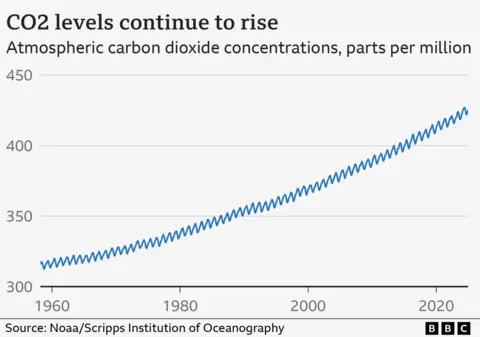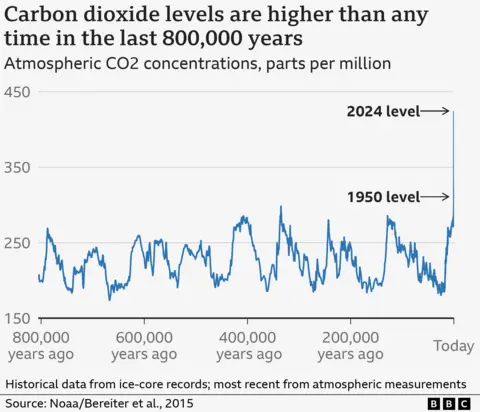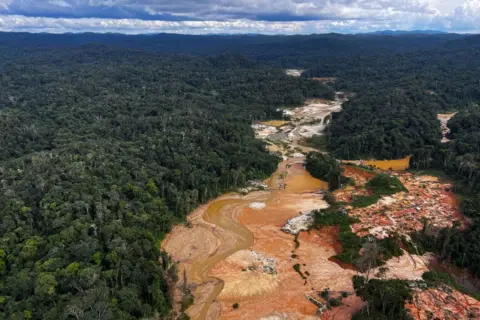 AFP
AFPLevels of the most important planet-warming gas in our atmosphere rose faster than ever before recorded last year, scientists say, leaving a key global climate goal hanging in the balance.
Carbon dioxide (CO2) concentrations are now more than 50% higher than before humans began burning large amounts of fossil fuels.
Fossil fuel emissions were at record highs last year as the natural world struggled to absorb as much CO2 as possible due to factors including wildfires and drought, so more accumulated in the atmosphere.
The rapid increase in CO2 is “incompatible” with an international pledge to try to limit global warming to 1.5C above pre-industrial levels, the Met Office says.
It was an ambitious goal agreed by nearly 200 countries at a landmark UN meeting in Paris in 2015, with the hope of avoiding some of the worst impacts of climate change.
This was confirmed last week 2024 was the warmest year on recordand the first calendar year in which annual average temperatures were more than 1.5C above pre-industrial levels.
This did not violate the Paris target, which refers to a longer-term average over a decade, but constant increases in atmospheric CO2 actually oblige the world to do so.
“Limiting global warming to 1.5C would require slowing the rise of CO2, but in reality the opposite is happening,” says Richard Betts of the Met Office.
The long-term increase in CO2 is undoubtedly the result of human activities, mainly the burning of coal, oil and gas and deforestation.
Data on Earth’s climate in the distant past from ice cores and marine sediments show that CO2 levels are currently the highest in at least two million years, according to the UN.
But the increase varies from year to year, thanks to differences in how the natural world absorbs carbon, as well as fluctuations in human emissions.

CO2 emissions from fossil fuels reached new highs last year, according to preliminary data from the Global Carbon Project team.
There were also effects natural phenomenon El Niño – where surface waters in the eastern tropical Pacific become unusually warm, affecting weather patterns.
Nature has absorbed about half of humanity’s CO2 emissions, for example through additional plant growth and much of the gas dissolved in the ocean.
But that extra burst of warmth from El Niño against the backdrop of climate change meant that the land’s natural carbon sinks didn’t take up as much CO2 as usual last year.
Widespread wildfires, including regions not normally affected by El Niño, also released additional CO2.
“Even without the boost from El Niño last year, the increase in CO2 driven by fossil fuel burning and deforestation would now exceed the IPCC (UN Climate Body) scenarios of 1.5C,” says Prof. Betts.
These factors meant that between 2023 and 2024, CO2 levels increased by nearly 3.6 parts per million (ppm) of air molecules to a new high of more than 424 ppm.

This is a record annual increase since atmospheric measurements were first taken at the remote Mauna Loa research station in Hawaii in 1958. Perched high on a volcanic coast in the Pacific Ocean, the station’s remote location away from major sources of pollution makes it ideal for monitoring global CO2 levels.
“These latest results further confirm that we are moving into uncharted territory faster than ever as growth continues to accelerate,” says Prof. Ralph Keeling, who heads the measurement program at the Scripps Institution of Oceanography in the US.
 AFP
AFPThe record increase raises concerns that the natural world could become less able to absorb planet-warming gases in the long term.
The Arctic tundra is turning into an overall source of CO2, thanks to warming and frequent fires, according to the US science group NOAA.
The the ability of the Amazon rainforest to absorb CO2 it is also affected by drought, forest fires and deliberate logging.
“It’s an open question, but it’s something we have to follow carefully,” says prof. Betts for the BBC.
The Met Office predicts that the increase in CO2 concentrations in 2025 will be less extreme than in 2024, but still significantly off target for reaching the 1.5C target.
La Niña conditions – where surface waters in the eastern tropical Pacific Ocean are cooler than normal – have replaced El Niño, which allows the natural world to absorb more CO2.
“Although there could be a temporary respite with slightly lower temperatures, warming will continue as CO2 continues to accumulate in the atmosphere,” says Prof. Betts.

